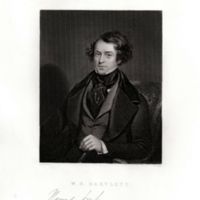Description
Born in Kentish Town, London, William Henry Bartlett (1809 - 1854) was a travel-writer, artist and engraver, who become one of the leading topographic illustrators of his generation. He travelled widely and produced works providing history and illustrations of the Balkans, the Middle East, and North America, of which The Pilgrim Fathers, or, The founders of New England in the Reign of James the First (1854) is a product. Bartlett died of fever on-board ship in the Mediterranean off the coast of Malta returning from a tour of Palestine.
By the end of the 1830s, Bartlett’s popularity was at an all-time high with his works selling well in Britain and abroad. The Critic praised his talent for illustrating landscapes:
‘Mr. Bartlett has a remarkable eye for the picturesque; all his views are taken from good points. He never fails to present us with a perfect picture, full of objects of interest, and conveying a better idea to place than any sketcher whose works we have seen of late years’.
Hussein I. El-Mudarris and Olivier Salmon note the ‘quality of the training in architectural drawing which the youthful Bartlett had received from [John] Britton’ and the ‘delicacy’ of his engravings which ‘reveal the artist's understanding of landscape and his ability to use light and shade with effect to enliven his scene’. In addition to his talent as an engraver, there was a growing market for attractive illustrated travel books in this period that helped further Bartlett’s popularity. The Pilgrim Fathers provides extensive illustrations of England, Holland, and North America and can provide evidence of the growing interest in the narrative during the nineteenth century.
You can find the British illustrations of Bartlett’s tour located on our map along with his topographic descriptions. His tour continued in Holland and New Plymouth, where he provides a detailed account of his illustrations in prose. His description of ‘Burying Hill’ in Plymouth typifies his style:
'The ‘Burying Hill’ is the most remarkable spot in Plymouth. From whatever side we approach the town, it rises conspicuously above all its buildings – a lofty green mound, covered with dark grey tombstones – the first place to receive the rays of the sun and the last upon which they linger.
Let us ascend to it by the narrow footpath from the head of Leyden-street – worn deeply in the thick and mossy turf – and seated on one of the tombstones, looked about upon the surrounding scene. What a Sabbath stillness reigns around! Scarcely a sound arises from the town below, half buried among its leafy groves; though the curling smoke tells of many a cheerful home concealed amidst the foliage. It is morning, the tide is in, the wide expanse of the bay glitters with light, and a fresh and bracing sea breeze pleasantly salutes us.'
The literary description adds to the romantic and picturesque nature of Bartlett’s engraving. A lonely graveyard looking over the bay which the Pilgrim Fathers landed provides readers with a rich sense of history and pathos. Bartlett is extending the Romanticism that Hemans brought to the Mayflower story in ‘The Landing of the Pilgrim Fathers in New England’ (1825) and which would be most overtly foregrounded in Albert Christopher Addison’s The Romantic Story of the Mayflower Pilgrims (1911). An extract from Bartlett’s work is used as the opening quotation for an WWI era educational pamphlet on the Mayflower by the Fellowship of Reconciliation, demonstrating that the text endured as part of the ‘canon’ of British Mayflower literature into the twentieth-century. Moreover, The Pilgrim Fathers, or, The founders of New England in the Reign of James the First shows the development of a ‘tourist trail’ of notable Mayflower sites – something Marcus Bourne Huish’s The American Pilgrim's Way in England (1907) would capitalise on over 60 years later.
Source
Hussein I. El-Mudarris and Olivier Salmon, Romantic Travel Through Bartlett's Engravings: From Europe to the Middle East (Aleppo: Ray Publishing and Science, 2007), p.16.
William Henry Bartlett, The Pilgrim Fathers, or, The Founders of New England in the Reign of James the First (London: Arthur Hall, Virtue & co, 1854), p.174.
No.3 The Pilgrim Fathers (York: W. Sessions, The Ebor Press, undated)

